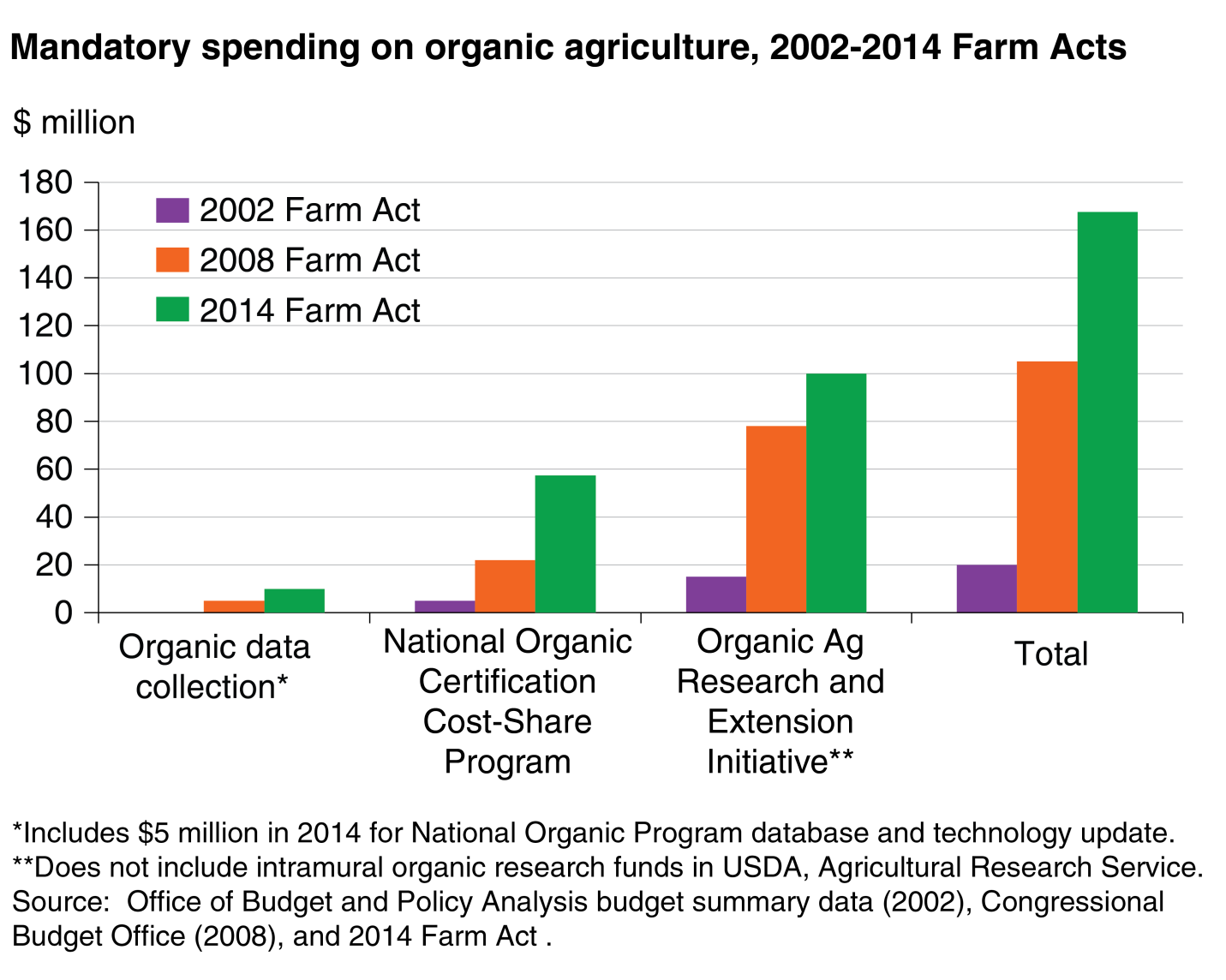Organic Agriculture: Title II (Conservation), Title VII (Research), Title X (Horticulture), and Title XI (Crop Insurance)
Aims to support the organic sector by expanding cost-share assistance for organic certification, maintaining the organic agricultural research initiative, and improving organic crop insurance and marketing programs.
Highlights
- Substantially expands funding to assist organic producers and handlers with the cost of organic certification.
- Expands total mandatory organic research funding.
- Exempts certified organic producers from having to pay for conventional commodity promotion programs on their organic production, and establishes the option for an organic promotion program.
- Requires improvements in crop insurance for organic producers and strengthens enforcement of organic regulations.
New Programs and Provisions
National Organic Certification Cost-Share Program (Title X)—Mandatory funding to assist organic producers and handlers with the cost of organic certification more than doubles from the 2008 Farm Act’s mandate, to $57.5 million over the lifespan of the Act.
Organic data initiatives (Title X)—Total mandatory funding to improve economic data on the organic sector continues at $5 million over the lifespan of the Act; another $5 million is added to upgrade the database and technology systems of USDA’s National Organic Program.
Organic commodity promotion orders (Title X)—Provision clarifies that all certified organic producers, including those that also have conventional farming operations, may be exempted from commodity promotion orders on their organic production; the option is established for the organic sector to develop an organic commodity promotion order.
National Organic Program (Title X)—Several new provisions are added to improve the enforcement of USDA’s program that regulates organic standards and certification. Authorized funding for the program expands to $15 million annually. The 2008 Farm Act had increased annual authorization from $5 million in 2008 to $11 million in 2012.
Crop Insurance for Organic Crops (Title XI)—USDA’s Risk Management Agency (RMA) is required to expand organic price elections for producers insuring crops by 2015. Producers choose a percentage of the maximum price set by RMA for their commodity which is used to determine the value of insurance coverage. For many commodities the maximum price election does not reflect the price premium that growers receive for their organic production.
Organic and transition support (Title II)—Conservation practices related to organic production and transition continue to be eligible for payments under an Environmental Quality Incentives Program (EQIP) provision added in the 2008 Farm Act. Payments to organic and transitional farmers under this provision remain capped at a much lower level than those to other farmers. However, farmers can choose the higher payment limit by enrolling in the regular EQIP program.
Organic Agriculture Research and Extension Initiative (OREI) (Title VII)—Total mandatory funding for OREI, USDA’s major intermural organic grant program, is set at $100 million.
Implications
- The total sales of organic products only accounted for one percent of total agricultural sales in 2007, the most recent Census of Agriculture estimate, and organic demand continues to outstrip supply. Partly in response to input and product shortages in organic supply chains, Congress boosted funding for organic research and other programs in the 2008 Farm Act and again in the 2014 Farm Act. Greater Federal support could mean more organic farms and production as U.S. consumer demand continues to grow.
- While farmers in over 100 countries are now producing food for the U.S. organic market, the number of certified farmers in the United States leveled off in recent years. The bump in funding for the organic certification cost-share program from $22 million to $57.5 million may help attract small-scale producers in particular; since the cap is high enough to cover a substantial portion of the fees for smaller operations.
- USDA's regulatory definition of organic farming specifies that practices be integrated to foster cycling of resources, promote ecological balance, and conserve biodiversity. Research needs are often region- and crop-specific, and renewal of the Organic Agriculture Research and Extension Initiative will help researchers address the backlog of research needs. The number of high-quality research applications for this competitive grant program has substantially exceeded funding since the program’s inception in 2002.
- A number of studies have found enhanced soil tilth, higher biodiversity, higher soil organic matter and productivity, lower energy use and reduced nutrient pollution with organic production methods when compared with conventional methods, according to a recent USDA Economic Research Service report. In the 2008 Farm Act, Congress cited the need for research on the potential of organic farming to capture atmospheric carbon and store it in the soil. In the 2014 Farm Act, Congress encourages research on weed and pest management for organic farming systems that maintains healthy water resources.
- Provisions of several farm programs that have made them less attractive to organic producers relative to conventional producers have been amended in the 2014 Farm Act:
- In the crop insurance program, an organic price election was available for only eight crops when purchasing crop insurance in 2013, although a few other crops produced under contract could be insured at the organic price specified in the contract. Under the 2014 Act, organic price elections will be expanded, making crop insurance more attractive to organic producers without contract prices.
- In the past, organic farmers have often been required to pay commodity assessment fees for programs that were not providing organic research or promotion. Congress clarified that all certified production is exempt from conventional orders and authorized a potential organic commodity promotion order, which would enable industry-funded organic research and promotion.
- Consumers cannot visually distinguish organic food from conventional, and must rely on labels and other advertising tools for product information. Congress passed the Organic Foods Production Act of 1990 to establish national organic standards that facilitate marketing and provide consumer assurance. USDA promulgated final rules to implement this legislation in December 2000. Many consumers have come to rely on the “USDA Organic” label. Congress added several new provisions in the 2014 Farm Act to improve enforcement of organic regulations, which will help maintain consumer confidence in the organic label.

